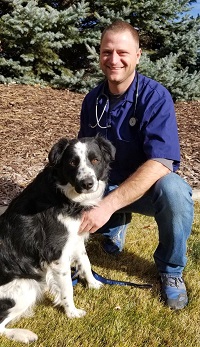There comes a time in every dog’s life when things begin to slow down. The games of catch become less exuberant. The patter of feet racing up and down your staircase becomes a little slower, a little more cautious. The enthusiasm is still there; their eyes sparkle when you come home from work and the wagging tail goes wild when you pick up their leash.
However, if your dog is struggling with a hip issue, then you’ll notice signs of rapid physical deterioration.
As with any loved one or family member, learning to adapt to and accommodate a physical change in your canine friend can be a trying endeavor. Watching your companion begin to wane and lose energy is one of the heartbreaking facets of being a dog owner. So, if you want your dog to age gracefully, it’s essential that you learn about the early warning signs of hip problems in dogs so that you can immediately take preventative and proactive counter measures.
Signs of Hip Problems in Dogs
There are a whole host of potential hip problems that your canine might encounter. The most commonly diagnosed issue is known as hip dysplasia. Like with humans, a dog’s hip joint is composed of a ball and socket. This allows for easy movement and rotation, permitting them to:
- Run
- Jump
- Sit
- Lay
- Pivot
- Play
Dysplasia in dogs occurs when either the ball or socket changes shape or is displaced. This limits the capacity for movement and creates a rubbing tension that gradually becomes more painful. It commonly produces swelling, which leads to stiffness. If this stiffness continues to worsen and the swelling isn’t treated, the foundation for arthritis can form.

The hip joint is used daily with little to no inactivity. This means that any pain or discomfort quickly exacerbates the problem. Of course, the larger or heavier the dog, the greater the stress on the joint, meaning that potential issues are likely to worsen quicker, limiting the time a dog owner has for preventative action.
Communicating to a pup that they need to take some bed rest is a mission that’s nearly impossible. The solution, therefore, is to aid prevention and assist by limiting the pain. So, if you are concerned that your dog might be struggling with hip dysplasia, look for the following symptoms:
- Limps or one-sided walks induced by a stiffening of the hip joint
- Movement that becomes slower and more limited
- “Bunny hopping,” or running with both hind legs moving together
- Frequent wobbles or a loss of balance
- Swaying while walking or leaning in one direction over the other
- Slow or difficult movement when sitting, lying down or standing up
- Wavering interest in going on walks
- Reduction of muscle tissue in hind legs that can result in “skinny hips”
Know What Your Breed Is Susceptible To
If you’re adopting a puppy it’s important that you do your due diligence; you must research the health risks of your preferred breed. The reality is that some dogs are more susceptible to hip or joint issues than others. You need to be aware of this prior to making the enormous commitment of owning a dog.
Ask yourself the following:
- Do I have the kind of lifestyle that can cater and adapt to looking after hip problems in dogs?
- Am I financially fit and available to handle any veterinary bills and appointments that might occur?
- Does my routine cater to my animal’s health? As in, will I be able to ensure they live a lifestyle that prevents the onset of hip problems?
Typically, we associate conditions such as hip dysplasia with larger dog breeds. However, the reality is that small and medium-sized dogs aren’t by any means immune to the risk of hip pain. If you own one of the following breeds, then the American Kennel Club advises you to remain extra vigilant in monitoring their hip health.
- Giant / Large Breeds – Great Danes, St Bernards, Chesapeake Bay Retrievers
- Medium Breeds – English Mastiff, Rottweilers, English Bulldogs, American Staffordshire Terriers, Retrievers
- Small Breeds – French Bulldogs, Pugs, Basset Hounds
Ask Your Breeder About Dysplasia Schemes
While certain large breed dogs are more susceptible, the reality is that hip problems are often inherited orthopedic issues. If you’re buying from a breeder, it’s vital that you play detective and ask ample questions about your puppy’s parents in order to truly gauge their medical history—you want to know the parents intuitively, as they can pass certain conditions down their bloodline. Let the health records of your dog’s parents serve as an enormous warning sign for the types of medical issues your dog is likely to experience.
If you’re purchasing from a legitimate breeder, then it’s highly recommended that you ask for evidence that this dog comes from a lineage of animals on a dysplasia scheme. Established by both the British Veterinary Association and the American Kennel Club in the late 90s, the scheme served to prevent the breeding of dogs with certain medicals issues, aiming to reduce the future likelihood of inherited genetic maladies.

The scheme demands that breeding dogs commit to a radiograph that will analyze the health of their joints, so that future buyers can have evidence of any pre-existing degenerative conditions.
Preventative Care
As a pet owner, it’s your responsibility to provide your animal with the correct measures of preventative care (long before you see the signs of hip problems in dogs). There are three key areas of preventative care that you should focus on:
Weight Control and Dietary Needs
A dog’s weight has a serious impact on rapid onset joint pain. This should be commonsensical. The more weight, the more stress placed on the joints. To that end, obesity in dogs is one of the primary causes of joint issues. So, if your dog is struggling with obesity, then it’s your utmost responsibility as an owner to tackle this problem immediately. You don’t want obesity to act as a catalyst for other health conditions that may arise.
Focus on the following:
- Portion Control – Ensure that your dog is not overeating. Avoid providing extra snacks and treats throughout the day. Break any bad habits you may have formed, like consistently feeding your dog from the dinner table.
- Healthy Snacks – Stay clear of meat-based treats or biscuits. Instead, reward good behavior with carrots, seeds, red berries and green apples for healthy alternatives. Train your dog to enjoy these nutritious snacks and learn to say no to their begging.
- Limit free-feeding – Veterinarians recommend creating a meal schedule of one meal a day, rather than leaving a bowl out and encouraging “free-feeding.” Focusing on one meal allows you to better control and regulate your dog’s eating habits and portion sizes.
Supplement your dog’s meals with nutritious compounds full of vitamins and minerals that will intentionally fortify your dog’s joint strength. Find a nutritional supplement that’s FDA approved and high in the following qualities:
- Chondroitin: Chondroitin helps to strengthen bone cartilage
- MSM: Reduces joint pain and swelling
- Omega 3: Eases stiffening joints (alongside a host of cognitive benefits)
Exercise
Prevent early onset hip issues by prioritizing regular exercise for your dog. While hip problems can occur at any age, the more you exercise your dog, the healthier they’ll be going into old age. Work to create a regular and disciplined walking routine, one that doesn’t falter due to your everyday life.
But Be Careful!
Paradoxically, it’s equally important not to over-exercise. Walks are the perfect balance of weight control and low-impact exercise that should be enough for their everyday needs. Extensive running and jumping could have a negative influence on your dog’s joints (especially if they’re puppies) and contribute to wear-and-tear over time.
Rest
Dogs—like humans—need their sleep. It allows their body the proper time to heal, thus aiding joint development and stabilization. If your dog isn’t getting enough sleep, or if their sleep routine isn’t structured, it could be one of the causes of hip dysplasia.
Key Treatment Responses
For many dogs, no matter how thorough your preventative care, hip pain will be an inevitably, likely striking towards the latter years of their lifespan. Once symptoms become apparent, it’s crucial that you provide your animal with the appropriate care, attention, and treatment. Possible therapies include:
- Hydrotherapy – Water is an incredible natural remedy. Not only is it a gentle and thorough source of exercise but a tremendous source of therapeutic care for stiff joints. If your dog enjoys swimming, speak to your veterinarian regarding hydrotherapy for hip dysplasia/hip pain.
- Physiotherapy – Sometimes, the pain brought about by hip problems can cause your dog to change their gait. This means they’ll compensate for the pain, walking in an awkward and unnatural motion. This could potentially disrupt other joint systems and cause even more long-term issues. The goal of physiotherapy is to help your dog develop a better gait, both isolating and compensating for the pain but not paving the way for future health risks.

Surgery
For some dogs battling serious hip dysplasia, surgery can be the only solution. Thankfully, hip dysplasia surgery is typically successful. If your vet recommends it as a viable solution, then it’s likely what needs to occur. It’s understandable that both the costs and risks associated with surgery can scare just about any dog owner, but at times the hip joint can become displaced to a point where no alternative methods will remedy it. Sadly, this will result in your lovely canine spending the rest of their days in pain.
In which case, there are three primary varieties of surgery for this specific issue:
- A Double or Triple Pelvic Osteotomy – Usually reserved for young dogs, this is a preventative surgery that involves rotating the ball and socket into their correct position, therefore mitigating the potential of hip dysplasia in the future.
- Femoral Head Ostectomy – Typically recommended for middle-aged canines, femoral head surgery involves replacing the ball joint. It’s less invasive than a total hip replacement but it certainly comes with its own set of risks.
- Total Hip Replacement – As the name suggests, a total hip replacement involves replacing a dog’s hip with a prosthetic one.
Next Steps
As a dog owner, you can never be too prepared. Even before you welcome a dog into your family, it’s vital that you think through all of the potential responsibilities, risks, and factors you’re signing up for. If you begin to see signs of hip problems starting to manifest, it’s an imperative that you receive the guidance—or, at the very least, consultation—of a professional.
This is not an issue that will allow you to standby as it “works itself out.” You have to be proactive with your dog’s joint health. This could be as simple as monitoring your dog’s diet to enforce weight control, to screening them by a vet and considering whether or not surgery is the correct avenue to embark upon. Regardless, there are tons of treatments for hip joint problems in dogs and, by doing your research, taking initiative, and talking to those knowledgeable, you’re sure to find one that allows your dog to live a mobile and healthy life.
 Reviewed by Dan Richardson, Veterinarian
Reviewed by Dan Richardson, Veterinarian
Dan Richardson has been a practicing veterinarian for over 10 years. He specializes in surgery and orthopedics. Dan is originally from rural western Nevada and attended the University of Idaho for undergraduate study and Oregon State University for Veterinary School. The Richardson Family enjoys camping and spending time on the water fishing, paddle boarding, or digging their feet in the sand somewhere warm.
Sources:
- American Kennel Club. Hip Dysplasia in Dogs. https://www.akc.org/expert-advice/health/hip-dysplasia-in-dogs/
PDSA. Hip Dysplasia in Dogs. https://www.pdsa.org.uk/taking-care-of-your-pet/pet-health-hub/conditions/hip-dysplasia-in-dogs - British Veterinary Association. Canine Health Schemes. https://www.bva.co.uk/canine-health-schemes/elbow-scheme/